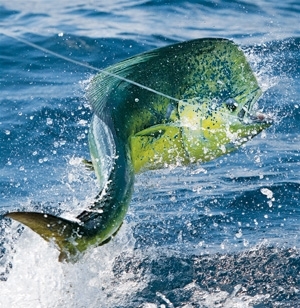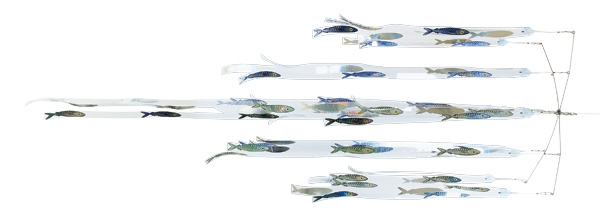
It was among the most humorous things I've seen on the water. Friend Harry Vernon III and I had a full spread of baits and teasers in play aboard my boat as we trolled offshore of Boat Harbour in the Abacos, Bahamas. Off the transom, a 96-fish Stripteaser dredge created the illusion of a large baitball some five feet beneath the surface. This fake smorgasbord proved too much for a 40-pound bull dolphin. Lit up like a neon sign, the bull charged the dredge and tried to devour the reflective bait decals.
I grabbed the flat-line outfit, which towed a medium-size ballyhoo at the surface and behind the dredge, and reeled the bait ahead of the feeding dolphin. But the dolphin was too focused on trying to eat fish decals to look up at my bait. I jigged the bait a few times, vying for the dolphin's attention, to no avail. Suddenly, it turned passive and began losing its vibrant colors. Did we blow our opportunity to catch it?<
What happened next really befuddled us; the dolphin, now dull green and blue, lethargically swam into the middle of the dredge and stayed there. Appearing relaxed, it seemed content to swim among the fish strips - and it did for a minute or so. Vernon later joked that it looked like the fish was either enjoying an invigorating massage from those plastic strips or trying to breed with the fish dredge. Whatever its inspiration was, we caught the dolphin, but this required me to reel the bait ahead of the commotion and free-spool it back past the dredge. Then the dolphin lit up and consumed the bait. It was the perfect pitch-bait tactic, executed with a flat-line bait.
What's the Pitch?
Pitch-baiting is primarily an offshore big-boat billfishing trick in which a couple of rigged outfits remain ready for deployment. Should a sailfish or a white or blue marlin rise behind a surface teaser or dredge, an angler grabs the appropriate outfit and pitches the bait back to the fish. If a fish is on a surface teaser, the angler's job is to position the bait so that it takes the place of the teaser - which is reeled up and away from the fish by the captain. The goal is to coax the fish off the teaser and onto the bait. If this is done correctly, the fish heats up and is likely to feed aggressively. This aggressiveness, combined with the short distance between the rod and the fish, means minimal line stretch, and successful hookups are the norm.
When a fish rises behind a dredge, it's basically the same drill, though the dredge remains in place. Like my earlier example with the dolphin, successfully hooking a fish in this situation often requires a bait free-spooled back and down to just alongside or behind the dredge, where it appears as if the predator has injured it. Should the tactic appear natural, the charged-up fish will consume the bait, just as our big dolphin did.
Some may question the merits of pitch-baiting. Won't a full spread of baits or lures already in place catch fish? A well-tuned trolling spread certainly will, yet pitch-baiting enables a crew to take advantage of a fish that rises onto teasers or behind dredges. And while Offshore Trolling 101 dictates positioning a bait near any teaser or dredge, there are instances when game fish will ignore these offerings. Unless you have a pitch bait ready to go, you could miss what might be your golden opportunity to catch that fish.
Too often this tactic is reserved for large sport-fishing vessels with cockpit space for extra rods and well-honed teams to play out the pitch-baiting game. But small-boat anglers can also incorporate pitch-baiting into their arsenal and run up their scores.
Successful Strategies
I've fished with numerous big-boat offshore pros, and many design their spreads and pitch baits around both large and small- to medium-size game fish. That is, they tend to fish large baits and teasers off one side of their vessel and small to medium baits and teasers off the other side. And they have at least two pitch-bait outfits rigged for each situation.
For example, take one friend who spends spring and early summer marlin fishing in the Bahamas: He'll drag a large hookless teaser, with a rigged splashing mackerel positioned some 10 feet behind that teaser, from the short outrigger. The long outrigger on that side is often a horse ballyhoo. The pitch-bait rods for that side include a Penn International 70 filled with 80-pound-test monofilament paired to a stand-up rod and small, fresh school dolphin. There's also a 50-pound-class outfit that carries a splashing mackerel. In theory, that's the side where a blue marlin will likely rise, so these pitch baits stand ready for deployment here.
The opposite side often consists of a squid or cedar-plug daisy chain and a mix of small, medium and large ballyhoo. Since this side should raise sailfish, white marlin and small blue marlin - along with dolphin - the designated pitch baits include a 50-pound-class outfit with a medium to large ballyhoo and a small to medium ballyhoo paired with a small conventional outfit filled with 30-pound-test monofilament.

This is not to imply that fish read magazines and therefore know which side of the bait spread to favor, but rather that successful big-game captains often design their spreads to attract specific fish and then back them up with the appropriate pitch-bait outfits. When a fish rises on a teaser - or even a bait - but doesn't strike, out goes a pitch bait. It's a thorough and aggressive way of fishing, and it creates positive results.
It must be noted that these individual pitch baits are rigged on appropriately sized hooks and leaders. That is, the blue marlin baits are on 300-pound-test leaders and hooks with enough bite and strength to latch onto and hold these fish, whereas the smaller baits are on leaders varying from 130-pound-test down to 80-pound-test for the smallest ballyhoo. This way, should a small white, sail or dolphin come up, the light leader shouldn't interfere with the bait's action. Try that with a larger bait and heavy leader, and the results will likely disappoint - hence the variation in bait and leader sizes and tackle.
Teaser Component
Teasers establish the foundation for pitch-baiting. The objective is not only to create more commotion and perceived panic among the baits in the wash but also to draw fish close to the transom, where they can be pitch-baited. And if a fish refuses the pitch bait and falls back, the close trolling baits and the far and center rigger baits may elicit a strike. So in essence, you still have several possible shots at that fish if you first lure it up close.
Using teasers can be as simple as cleating off a large hookless lure at each corner of the transom. Aboard my center console, I run a large Bost Americano teaser off the starboard side and a Williamson squid spreader bar off the port side, both of which are controlled by T-top-mounted teaser reels. I run the teaser lines through all three eyes of my outriggers to get the teasers working in the clean water, well outside the prop wash. The drags on those teaser reels are set to where they just hold the teasers in place, yet not firm enough so a fish crashing and running with a teaser will buckle an outrigger.
A pair of 96-fish Stripteaser dredges rides from each transom cleat. Between the surface teasers and dredges, along with the flat lines and short outrigger baits, there is a lot of commotion behind the boat. In short, it's a good recipe for raising fish into pitch-baiting range.
Think Variety
As I mentioned earlier, pitch-baiting is primarily a billfishing tactic, but it certainly isn't limited to these fish. I've used the method to score plenty of dolphin, and occasionally for casting small ballyhoo and baits into busting fish such as blackfins, skipjacks and even yellowfins.
There's no denying its effectiveness. I know. I've caught fish this way while traveling and fishing aboard big boats and even while aboard my own center console. If you're looking to ramp up your trolling game, this is an excellent tactic to incorporate ASAP!

